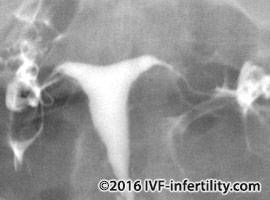Hysterosalpingogram (HSG)
The term hysterosalpingogram, also known as HSG, refers to an x-ray of the womb and tubes. The uterus and Fallopian tubes are invisible on the X-ray. To make them visible in the hysterosalpingogram a special X-ray fluid (contrast medium) is injected via the neck of the womb. The contrast medium shows up on the X-ray and outlines the shape and contours of the uterine cavity and may also work its way along the tubes. HSG is usually recommended in low-risk infertile patients to demonstrate a blockage in the tubes and to check the openness of the Fallopian tubes following tubal surgery, it may also demonstrate an abnormality within the womb cavity .
The hysterosalpingogram procedure is performed in the X-ray department and usually takes about 15-20 minutes.
How is the HSG procedure carried out?
The patient lays on a table under the X-ray imager. The doctor inserts a speculum (an instrument inserted into the vagina to visualize the cervix), cleans the cervix from any discharge, then a fine tube is inserted through the cervix and a special contrast medium is injected. The flow of the dye from the uterus to the tubes is observed through an X-ray image intensifier (which looks like a TV screen). In a normal HSG the contrast fills the womb cavity and enter the tubes and spills out of the ends of the tubes into the pelvic cavity. Films of the HSG are usually taken for the record.HSG showing patent tubes

HSG showing distal tubal blockage

HSG showing both tubes are blocked proximally

HSG showing bicornuate uterus

HSG showing unicornuate uterus

No anesthetic is required when performing the HSG, but some mild discomfort similar to period pain may be experienced. This can be greatly reduced by taking pain killer tablets. The test has to be performed in the first half of the cycle after menstruation has stopped and before ovulation, to avoid x-ray exposure to a fertilized egg. Serious problems are rare, allergic reaction to the contrast medium. Other complications include pelvic infection which occur in 1-2% of cases. This usually occurs in the presence of previous tubal disease. A course of antibiotics is usually given after the procedure to prevent the possibility of infection. Fainting is a rare complication the patient may get light headed during, or shortly after the procedure. Spotting commonly occur for one or two days after HSG. You should notify your doctor if you experience heavy bleeding after HSG. Radiation exposure from HSG is higher than that of a standard chest X ray.
In general HSG identifies blocked tubes in just over 50% of cases while correctly identifies patent tubes in over 80% of cases. Tubal spasm may occasionally obstruct the proximal end of the tube (near the uterus) during the HSG, and gives a false impression of tubal blockage on the screen. Furthermore, the HSG provides little or no information about peritubal adhesions that could impair the tubal function..